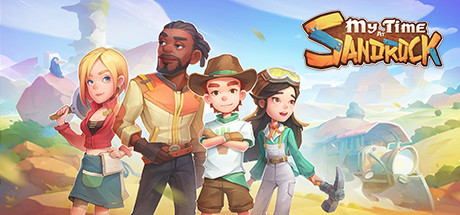I like this game. They managed to make a sequel to My Time At Portia, and make the story and distinct while leaving a recognisable gameplay loop.
Once again, you’re a builder who completes commissions for money and renovates the town. Except it’s clear something is different. While Portia is a bustling port town with a health ecosystem of builders, Sandrock is a little more, oof. The town has been barely struggling by with a builders guild leader who is as lazy as he is infuriating to talk to, and a builder who has clearly had enough. You and your friend Mi-an have both moved in to replace the retiring builder.
Needless to say, you’re gonna have to wing it.
I came from Portia, so I had a bit of an advantage of knowing the game’s core gameplay loop. Some things have changed, trees are such a big deal in Sandrock that it’s illegal to fell them, so wood gathering becomes a slightly more difficult task. Your first machine will almost certainly be a recycler to recover materials from scrap. The overall world between the two games is shared. Both Portia and Sandrock belong to the Aliance of Free Cities; both games take place just short of 200 years after the Calamity; and both towns follow the teaching of the Church of the Light. Though with Sandrocks far harsher conditions, the church is generally less strict about repurposing Corruption era technology to aid survival. In fact a lot of your tasks as a builder will revolve around scavinging for old world tech to help improve the town due to the church’s ideals disallowing them from doing it themselves. Involving yourself in church affairs is entirely optional of course, but you do still have to conserve water and protect trees.
Sandrock is a difficult environment to work in. Water is a scarse resource. It’s required for all your machines to function in fact, since without it they will overheat. You can gather resources from picking plants or mining sandstone in the form of dew, each piece of dew translating to 1 unit of water once you craft it. You can also purchase a small quantity of water per day assuming something terrible hasn’t happened to the town’s water supply. Dew collectors also slowly collect dew over time, once you can make them.
The game also features a new quality mechanic to give a use to all the gems you gather and have no use for. Starting in the mid game, you might find commissions for higher quality items (the 3 quality tiers are Green, Blue, and Purple,) and you may want to pay attention to them (or roll back a save) if you don’t have the means to make them. Unlocking the refiner is a must to solve these commissions. The refiner takes a material, machine, or tool, and improves its quality tier (or rerolls its stats) at the cost of some gemstones.
Researching is done differently. In Portia, Petra would take a number of discs and then send the player a random blueprint from that numbers pool of potential blueprint. Sandrock however lets the player choose which blueprint to have Qi research, allowing the player to plan better for what machines they will have access to. The downside to this is that Qi’s blueprints are broadly more expensive and take longer to research than Petra’s, there are also more that need researching.
All in all, a very solid experience. Sandrock feels like a far more close-knit town than Portia ever felt like, and thats a good thing in my opinion, as it makes it easier for the player to experience more subplots and stories. The stories of both games, while being distinct, both share the same fundamental worldbuilding to make the transition from one game to the next relatively seamless, rather than invalidating all previous experience and history.
Steam: https://store.steampowered.com/app/1084600 £34.99
Humble Bundle: https://www.humblebundle.com/store/my-time-at-sandrock £34.99
Switch: https://www.nintendo.co.uk/Games/Nintendo-Switch-games/My-Time-at-Sandrock-2370306.html £30.59

Leave a Reply